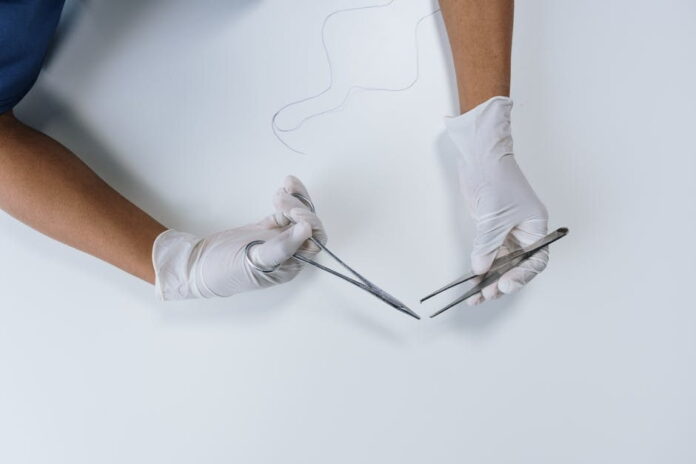Between 40-50 million surgeries take place each year in the United States. Suturing is a vital skill for all types of surgeons. It can be a life-saving technique in emergency situations.
Mastering suturing techniques is essential for providing the best patient care. It requires a high level of dexterity, precision, and hand-eye coordination. It can only be attained through consistent practice.
This is where suture practice, comes into play. In this article, we will explore different methods to practice suturing and improve your suture skills.
These will help whether you are a beginner or a seasoned professional. Our tips and techniques will help you improve your suturing skills.
Benefits of Practicing Suturing
Suturing is a crucial skill for medical professionals. Practicing suturing can provide a range of benefits. One of the key advantages is the improvement in hand-eye coordination.
By performing sutures often, you can develop greater precision in your movements and increase your dexterity. This can translate to improved performance in other areas of medicine and surgery.
Suture practice can also improve your spatial awareness. This is because suturing requires you to work within a specific area. You must be able to navigate and manipulate instruments with precision and care.
Knot tying is an essential part of suturing. By practicing this skill, you can develop a greater understanding of how to tie different types of surgical knots.
This is useful in emergency situations, where time is of the essence. The ability to tie a secure knot fast can make all the difference.
Suture for Beginners
If you’re new to suturing, it can be intimidating to try the technique for the first time. With a bit of practice and the right tools, you can develop your suture skills. Here are some tips to help you get started:
Familiarize Yourself With the Tools
To practice suturing, you’ll need to buy a suture practice kit. They include suturing needles, thread, and forceps. Make sure you know what each tool is used for before you start.
Start with Easy Materials
It’s best to start practicing suturing on soft, pliable materials such as fruit or foam. This will prepare you to move on to tougher materials like skin.
Practice Your Hand-eye Coordination
Suturing requires a lot of precision and dexterity. Practice moving the needle through the material while keeping your hands steady.
Watch Instructional Videos
There are plenty of instructional videos available online. They can help you learn the basics of suturing. Watch these videos to get a better understanding of the technique.
Don’t be Discouraged
Suturing is a skill that takes time to develop. Don’t be discouraged if your first attempts are not perfect. With practice and patience, you can master the technique of suturing.
Suturing on Fruit
For beginners, practicing suturing on fruit is an excellent way to get started. Not only is it cost-effective, but it mimics the texture and toughness of human skin.
When practicing suturing on fruit, it is important to choose the right fruit. Apples, pears, and oranges are some of the best fruits for suturing practice.
To prepare the fruit for suturing, wash it and cut it in half. Make sure to remove any seeds or pits from the fruit. Using a suturing needle and thread, practice suturing the two halves of the fruit together.
Common Mistakes to Avoid
Suture for beginners can be tricky. One of the most common mistakes they make while practicing on fruit is pulling the thread too tight. This leads to fruit splitting.
It is crucial to make even stitches and place them at the right distance from each other.
Suture Practice Kits
Suture practice kits are an excellent tool for beginners who want to master the art of suturing. These kits come equipped with all the necessary items required for practicing suturing. They make it easy and convenient for beginners to start.
There are different types of suture practice kits available in the market. The most common type is the basic suture practice kit. It includes suturing needles, suturing thread, and forceps.
Other advanced kits may include more items such as:
- Suture pads
- Scissors
- Practice skin
The basic suture practice kit is an excellent choice for beginners who want to learn how to suture without spending too much money. The kit is portable, making it easy to practice suturing on the go. These kits are inexpensive, making it an affordable option for:
- Medical students
- Interns
- Residents
Beginners should start by familiarizing themselves with the different types of suturing needles and threads. Once they understand the various types, they can begin practicing suturing techniques using the kit’s tools.
Tips to Improve Suture Skills
Suturing is a skill that requires consistent practice and attention to detail to master. Here are some tips to improve your suturing skills. This will increase your confidence in performing this essential technique.
Practice Different Suturing Techniques
One of the best ways to improve your suturing skills is to practice different suturing techniques often. This will help you become familiar with the different types of sutures and the best situations to use them. Focusing on proper needle handling helps to avoid damaging tissues and achieve precise stitches.
Knot Tying
Another key aspect of suturing is knot tying. Mastering the proper technique for knot tying improves the strength and appearance of the suture.
One helpful tip for knot-tying is to use a consistent knot-tying technique for all sutures. Ensure that they are uniform in size and appearance.
Stress-Free Environment
Practicing suturing in a stress-free environment can also be beneficial for improving skills and building confidence. It is important to create a comfortable and relaxed environment that mimics a clinical setting. This can help reduce anxiety and improve performance.
Get Feedback
Seeking feedback from mentors or experienced professionals is helpful in improving suturing skills. They can provide valuable insights into proper techniques and offer tips for improvement.
Upgrade Your Skills With a Suture Practice Kit
Consistent suture practice is necessary for all medical professionals. It’s even more crucial for beginners to develop their skills. There are various methods and kits available for practicing at home.
This guide provides many tips to improve suturing skills. By following these tips and using the right tools, beginners can develop their suture skills and gain confidence. Stay up to date on the medical industry by reading more articles in our practice management category.
Read Also
- Why the Keto Diet Works for Some People—and Fails Dramatically for Others: An Ayurvedic Breakdown for Modern HealthcareThe keto diet has dominated weight-loss culture for years. For some people, it produces rapid fat loss, stable energy, and improved mental clarity. For others—especially those who gain weight easily—it leads to burnout, digestive distress, rebound weight gain, high cholesterol, and a metabolism that feels slower than before. Healthcare often frames this as a discipline… Read more: Why the Keto Diet Works for Some People—and Fails Dramatically for Others: An Ayurvedic Breakdown for Modern Healthcare
- How to Choose the Best Assisted Living Facility for SeniorsAre you looking for the right assisted living facility for a senior loved one? Choosing a place can feel overwhelming. There are many factors to consider, from care services to the environment. Safety, comfort, and social opportunities play important roles in daily life. Each senior has unique needs and preferences that must be met. Understanding… Read more: How to Choose the Best Assisted Living Facility for Seniors
- Burn Smart, Not Hard; Shape Burn: Clean Protein for Weight ManagementYou want to feel light, strong, and confident. You don’t want crash diets or fake promises. You need a plan that works with your body, not against it. That’s where Shape Burn comes in. You can burn fat without losing strength. You can eat better and stay full. You can manage weight in a way… Read more: Burn Smart, Not Hard; Shape Burn: Clean Protein for Weight Management
- Creatine Basics: How Much Is 5g, How Much Water You Need, and Whether Pills or Powder Work BetterIf you’ve ever walked into a supplement aisle or scrolled through fitness TikTok, you’ve probably seen people talking about creatine — usually with a shaker bottle in hand and promises of better workouts and faster gains. And honestly? They’re not wrong. Creatine is one of the most researched and effective supplements for muscle strength, recovery,… Read more: Creatine Basics: How Much Is 5g, How Much Water You Need, and Whether Pills or Powder Work Better
- Understanding Breast Cancer in Men: Key Facts and SymptomsBreast cancer is often thought of as a disease that only affects women. However, men can develop it too. Although it is less common, early detection and awareness are important. Read on to learn key facts, symptoms, and ways men can take action to protect their health. How Common Is Breast Cancer in Men? Breast… Read more: Understanding Breast Cancer in Men: Key Facts and Symptoms
- Raising Awareness: Breast Cancer Facts for Older MenBreast cancer does not affect only women, and many older men do not realize they are at risk. Because the signs can be easy to miss, many men learn about the disease only when it has progressed. Learning the basic facts now can help you stay aware and respond early. If you want to protect… Read more: Raising Awareness: Breast Cancer Facts for Older Men







